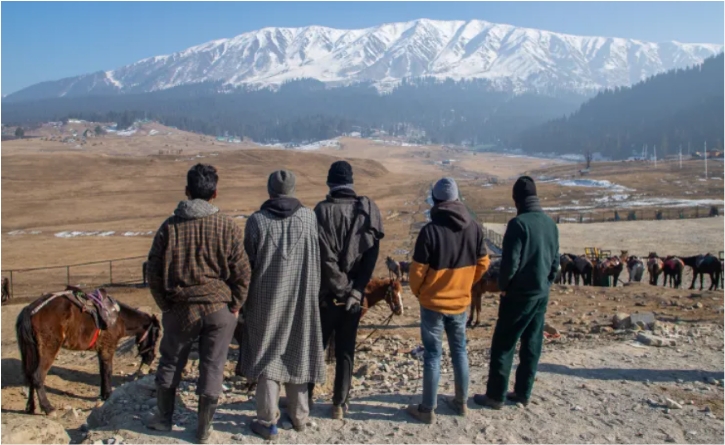In a disheartening turn of events, the breathtaking ski slopes of Gulmarg in Indian Illegally Occupied Kashmir (IIOK) are grappling with an extraordinary challenge this winter. The region, renowned for its picturesque landscapes and vibrant tourism industry, is facing an unusually dry spell that not only disrupts the tranquility of its snow-covered vistas but also poses a severe threat to the livelihoods of many.
The once vibrant ski trainers and mountain guides, accustomed to the bustling activity between December and February, find themselves abruptly out of work. All ski bookings until early February have been canceled, leaving professionals like Ahmad contemplating alternative livelihoods as the region navigates through this unexpected crisis.
Gulmarg, situated near the Line of Control that divides Kashmir between India and Pakistan, now bears witness to a hauntingly deserted landscape. In stark contrast to the region’s historical abundance of snow, which reached impressive heights of 30 to 40 feet at higher altitudes, the current dry spell has reduced it to a mere three feet. This unprecedented lack of snowfall has not only shattered the routines of seasoned professionals like Ahmad but has also triggered a reevaluation of their careers in the face of an uncertain future.
Muhammad Yasin, one of the oldest ski trainers in Gulmarg, expresses profound sadness at the desolate state of the ski grounds during what would typically be a thriving season. The repercussions of the dry spell extend beyond the ski trainers themselves, posing a substantial threat to the broader economy of Kashmir (IIOK), where tourism plays a pivotal role. In 2023, the region welcomed 16.8 million tourists, and in 2022, after almost three years of lockdown, the number surged to 19 million. The region had already weathered significant challenges in 2019, marked by the revocation of its special status, a subsequent security clampdown, and the disruptive impact of the COVID-19 pandemic.
Tourists, like Muhammad Suhail, share their disappointment at the scarcity of snowfall. The looming fear of another wasted year not only affects ski trainers but also casts a shadow over hoteliers, guides, and various other workers dependent on tourism. This situation emphasizes the vulnerability of Kashmir’s economy to external factors, highlighting the profound impact of climate variations on the region’s ongoing challenges.
As the dry spell persists, the fate of this year’s tourism season in Gulmarg hangs in the balance, creating a ripple effect that touches the lives and plans of both locals and visitors. The story, as reported by Al-Jazeera, encapsulates the profound struggle faced by a community that thrives on the beauty of its snow-covered landscapes but is now grappling with the harsh reality of an unprecedented climatic shift.

